| At the heart of Wolverhampton's Great
Western Railway freight activity, Mervyn Srodzinsky
traces the evolution of Oxley's railway infrastructure
and vast sidings, as well as covering the engine shed's
changing allocation through to closure in 1967. |
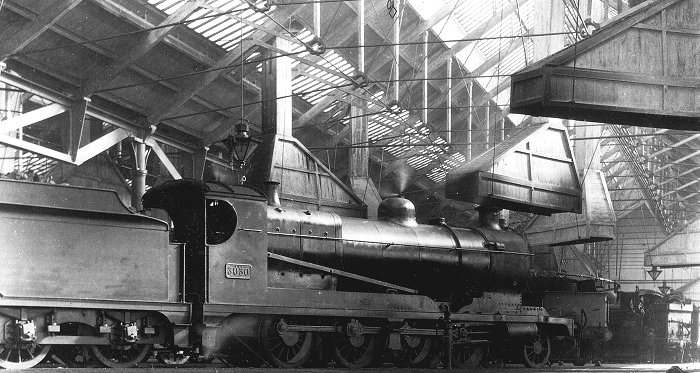
Opened in 1907 as the primary engine shed for GWR
Wolverhampton area freight activities, the lion's
share of locomotives using Oxley's roundhouse met
this criteria through to the 1960s. This scene,
photographed in the late 1920s or early 1930s, finds
an ex-Railway Operating Division 2-8-0 at rest
inside the shed during its time as GWR No 3030.
Designed by J. G. Robinson for the Great Central
Railway, these engines were adopted by the ROD and
the Ministry of Munitions for use during World War
I, with some seeing employment with the GWR in this
period. Post-war, many were sold to the LNER and GWR,
some after overseas service, the latter purchasing
twenty of the nearly-new engines in 1919. In the
July of that year another 84 were hired-in by the
GWR, but these were returned just prior to the
Grouping, the depicted engine being from the batch
of eighty subsequently bought in 1925. A number of
these engines were allocated to Oxley shed, and they
could be found working from here into the mid-1950s.
Notice the pull-rings attached to the gas light at
the very top centre of the photograph, with circular
and diamond shapes for 'on' and 'off'. R. S.
Carpenter Photos. |
|
It was during the latter part of
the 1870s era that the Great Western Railway management
decided to make provision for some goods sidings to be
established on a site adjoining each side of its
existing main line at Oxley, Wolverhampton. The location
chosen for the sidings was about one mile north-west of
Wolverhampton (Low Level) station, on the northern side
of the Oxley viaduct, as it presented an area of land of
sufficient width (subsequent to some additional
excavation and levelling), and also allowed convenient
access to the main line. Following on-going sale
negotiations with the various local landowners, the
purchase of the land was finalised and the sidings were
laid down. By 1880 there were eight roads in use that
were controlled by two signal boxes, which were known
appropriately as North and South boxes.
The Oxley viaduct was constructed
by the Shrewsbury & Birmingham Railway (S&BR) in 1847,
and it opened for use in 1849. The S&BR was subsequently
incorporated into the Great Western Railway from
September 1854, and henceforth the viaduct carried the
Great Western's mainline route from London (Paddington)
to the north-west, serving such places as Shrewsbury,
Chester, Birkenhead, and even Manchester, and from then
until 1869 Oxley viaduct was the most northern running
point of Brunel's broad gauge railway system. The
standard gauge former S&BR running lines over the
viaduct were converted to mixed gauge, with a crossover
near the southern end, together with a junction leading
to the former S&BR terminus at Victoria Basin goods
depot, which was located back down the line towards
Wolverhampton.
The blue brick-built viaduct
comprises twelve arches, one of which is a skew arch
across the BCN canal (Birmingham Canal Navigation). From
post-1854, the immediate approach route from the south
was from Wolverhampton (Low Level) station, passing
through Dunstall Park station (1896) and running
adjacent to the Stafford Road Locomotive Works, and then
over Stafford Road Junction and on to the viaduct. The
exit from the viaduct, towards Wellington and
Shrewsbury, passed through Oxley sidings, with Oxley
locomotive shed off to the left-hand side. Oxley viaduct
remains in use to date, and it became a listed building
from 31 March 1992.
The 1887-dated Ordnance Survey map of Wolverhampton
shows that by then the Oxley sidings had been further
developed, having almost doubled in size at their widest
point. During 1897 two new signal boxes were built and
brought into operation (replacing the earlier boxes) in
order to deal with the ever increasing amount of goods
traffic and through main-line passenger workings. The
sidings also evolved, with the various roads being
utilised for specific goods train destinations, and by
October 1897 major alterations had been carried out in
connection with additional goods lines, together with a
further expansion of the yard. The two replacement
signal boxes continued to be designated 'North' and
'South'. The Down sidings were immediately to the left
after crossing Oxley viaduct (heading north), and these
sidings were split into the 'Crewe', 'Birkenhead',
'Old', and 'New' yards, and, having been built on a
slight gradient, wagons could be moved by gravity. The
Up sidings over to the right were not as extensive in
width, being restricted topographically by way of a
raised sandstone ridge that required extensive
excavation work. |
|
The layout of
Oxley sidings, as detailed in an Ordnance Survey of
1887.
The bottom
right-hand portion of the map shows the GWR main line
crossing over the Oxley viaduct, with the Birmingham
Canal (often known as the BCN) running beneath it.
The sidings
would eventually be expanded outwards to the left by way
of the purchase and levelling of various parcels of
available farmland.
Courtesy of
Ordnance Survey historical map archive. |
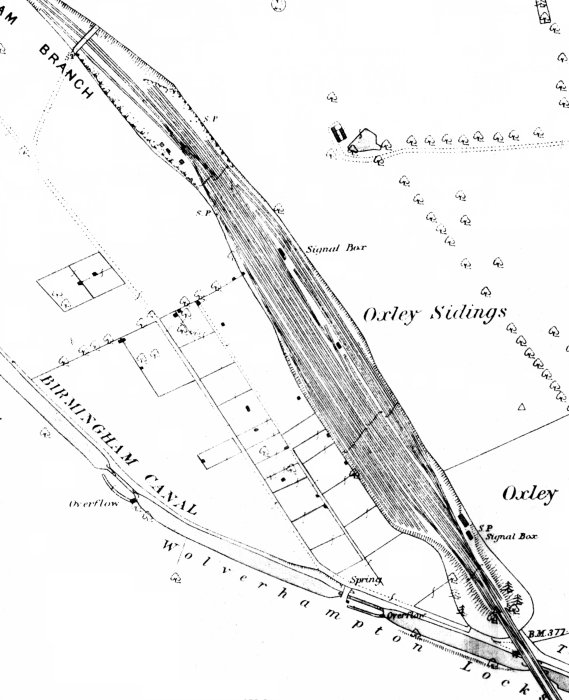 |
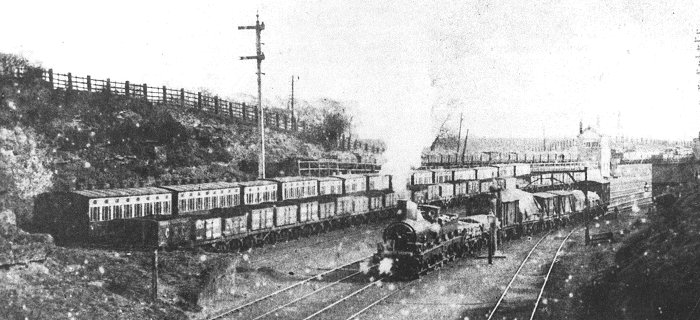
An 1897 view of Oxley sidings,
photographed from a narrow pedestrian footbridge that
once spanned the northern end of the site, shows
alterations in progress to accommodate the 'Crewe' and
'Birkenhead' goods marshalling yards. Just visible on
the far right is a new signal box under construction,
and this would eventually replace the earlier box seen
to its left. This replacement signal box would be
designated 'Oxley North' until the building of the
Wombourne line in the 1920s required the erection of
another signal box, and at that time the old Oxley North
box would then become known as 'Oxley Middle'.
An outside-framed Armstrong 0-6-0 goods engine at work
in the yard is of interest, together with the typical
early tall GWR semaphore signal. The line of ancient
oil-lit four and six-wheeled passenger coaching stock,
in the sidings to the left, may include some of pre-GWR
origin, and the apparent width across the end of the
body of the nearest coach appears to suggest broad-gauge
stock. However, as 1869 saw broad-gauge working
withdrawn completely from Wolverhampton it would be
remarkable if such stock was still lingering after a gap
of 26 years, the link being that the extreme northern
limit of the GWR's broad gauge system extended across
Oxley's S&BR viaduct into some early sidings hereabouts.
Close inspection of the original photograph (which
allows extra distance to the left) does not suggest that
there is any form of lens distortion to take into
account, while perusal of the Ordnance Survey map
prepared some ten years earlier does not assist either
as all the trackwork appears to be drawn to the same
gauge by the draughtsman. There is also the possibility
that the illusion of extra width is due to the coach's
shadow on the face of the cutting to the rear. Thus the
situation remains open to debate. Author's Collection. |
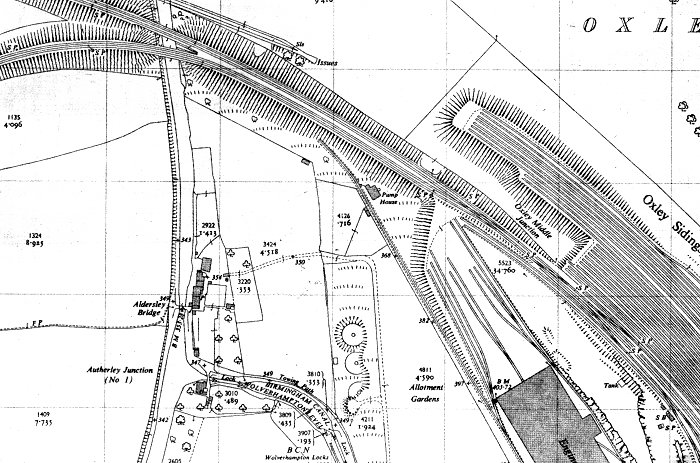
An OS map shows the GWR main line from the north-west
nearing Oxley, after a period of continued siding
expansion, the building of the associated engine shed on
the Down side of the main line, and the completion of
the Wombourne line in 1925. The original Shrewsbury &
Birmingham Railway route appears at the top left-hand
corner, the line joining this being the through route
from Kingswinford Junction via Wombourne. Incoming
trains from these routes would pass between Oxley's Up
and Down yards before crossing Oxley viaduct, then reach
Stafford Road Junction; from there, most would diverge
left for Wolverhampton (Low Level) station, but a course
straight ahead would lead to the Victoria Basin
terminus. Of note is the excavation undertaken for the
dead-end sidings on the Up side, while on the opposite
side of the line is the locomotive shed. The sidings to
the rear of the shed would be used to store large
numbers of withdrawn steam locomotives in the mid-1960s.
Courtesy of Ordnance Survey historical map archive. |
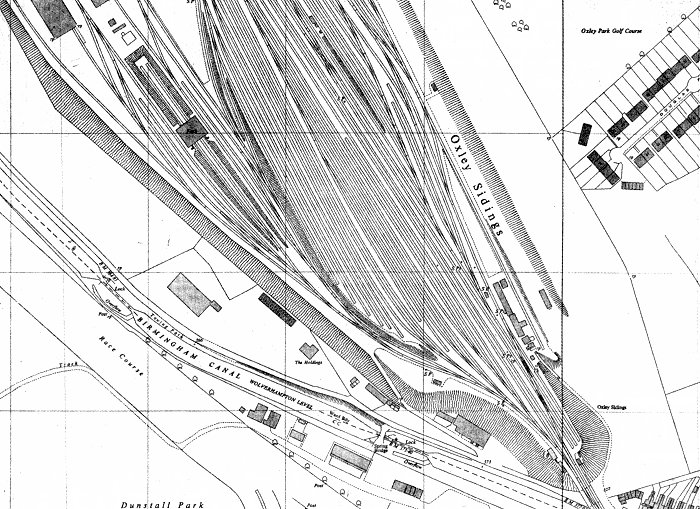
An extract from a 1930s' Ordnance Survey map shows the
other end of the yard once Oxley sidings had been
enlarged outwards to its final extent. The locomotive
shed's coaling bay and elevated water tank are shown on
the upper left-hand side of the map, while Oxley viaduct
is to the bottom right, Oxley South signal box being
sited just to the north of the viaduct. Courtesy of
Ordnance Survey historical map archive. |
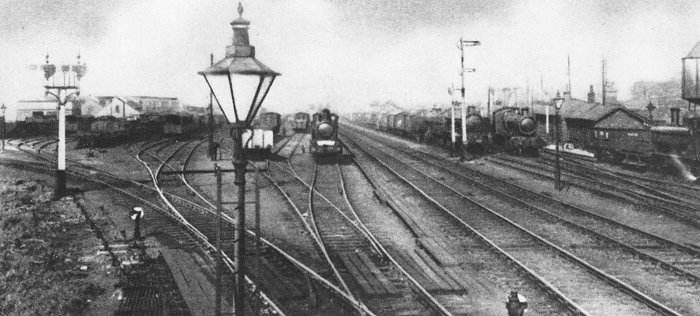
The view looks north from Oxley South signal box, at the
north end of the viaduct. Looking right to left, just in
view is the 'mushroom' water tank, next to the offices
for the sidings staff, then the layout is the Up
sidings, the Up main-line, Down main-line, and then the
busy Down sidings, the engine shed visible beyond these.
Prominent in the foreground is a Sugg's 30-inch hexagon
case lamp which would remain in situ almost to the end
of steam working, while the nearest line to the signal
box gives access to the engine shed. Author's
Collection. |
|
It soon became apparent that a
separate locomotive shed for goods engines was
necessary, and in view of this requirement, Oxley shed
was authorised for construction alongside the sidings.
From thereon, freight trains arriving at Oxley sidings
from the south would come to a stand on the viaduct, the
engine then being taken off and allowed to go into the
new locomotive depot for service. Shunters, known as
'droppers-in', would then uncouple the train's goods
wagons (having previously read the destination labels),
shouting to the signalman in the South box which yard
was required, and the wagons were then dropped-in as
appropriate by gravity. Rough destination sorting was
carried out using hand-controlled points operated by the
shunters, who were also responsible for braking the
wagons, which could be a hazardous operation. The goods
train, still waiting on the viaduct's main line, was
held in place by its brake van, controlled by the guard
until such a time as motive power could be provided to
move it onwards following sorting.
On 11 January 1920 the North signal
box was re-designated 'Middle' signal box, and by 1930
Oxley sidings had expanded out to their final limit,
providing the Great Western Railway with its principal
Midlands reception and marshalling area. The final
making up of trains was carried out at the north end of
the yard by a locomotive and the shunters (some power
being required to get up speed) enabling the wagons to
be fly-shunted in what was known as an 'Up Hill' yard.
In due course some fourteen vacuum-fitted express goods
trains were regularly made up at Oxley sidings, some of
which were actually given names, such as 'The Cargo',
'The Northern Exchange', and 'The Flying Skipper', and
others, such as 'The Northern Flash' from Paddington to
Birkenhead, passed through, picking up at Oxley sidings
on route.
The only serious damage that was ever sustained by a
train from Oxley sidings occurred in October 1928 when
the 9.15am Down fitted goods train from Oxley to Bristol
was involved in a serious accident on the LMS line at
Charfield. In that incident the Great Western locomotive
and three wagons were hit by an LMS express over-running
its signals just as the goods train was setting back
into the refuge siding. As a consequence, the gas-lit
coaches of the express burst into flames, leaving
fifteen people dead. |
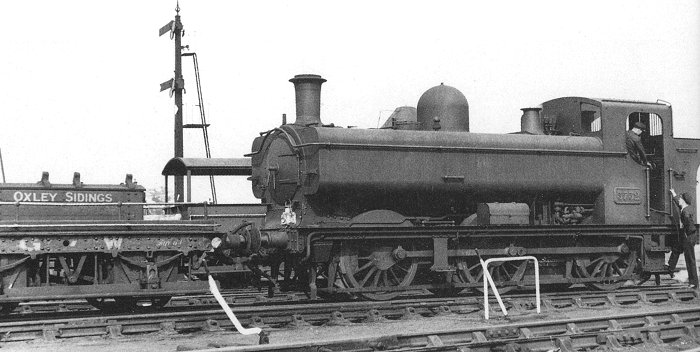
An undated photograph of Oxley
sidings - probably taken shortly after the depicted
'5700' class 0-6-0PT, No 3732, was outshopped new from
Swindon Works on 31 August 1937 - shows shunting at the
southern end of the yard. Note the shunter's wagon
designated for use at Oxley sidings. Author's
Collection. |
|
Following the war years very little
changed at Oxley. After the Nationalisation of the
railways in 1948, normal day-to-day goods operations
continued up until the mid-1960s, when the continuing
withdrawal of steam locomotives brought additional use
of the sidings for the storage of all sorts of former
GWR, LMS, and LNER locomotives on their way for
scrapping, many of which ended up at local Black Country
dismantlers, such as Cashmore's and Cox & Danks. Also
during the course of the mid-1960s British Railways
submitted outline plans to the Wolverhampton County
Borough Council for consideration with a view to setting
up a diesel maintenance facility across part of the
Oxley sidings site. However, in the event, this proposal
was not pursued past the early discussion stage,
although the large detailed plans drawn up in this
respect still exist.
When the adjacent engine sheds were closed down in 1967,
much of the sidings were subsequently taken out of use
and lifted. By 1973 the extent of the sidings had been
effectively reduced by at least a third, although some
alterations during the course of 1976 resulted in some
new lengths being laid down, the yard then presenting a
more streamlined appearance. What remains of the sidings
at Oxley has now been incorporated into a new
development, which is used to provide stabling
facilities for modern Alstom-built stock. |
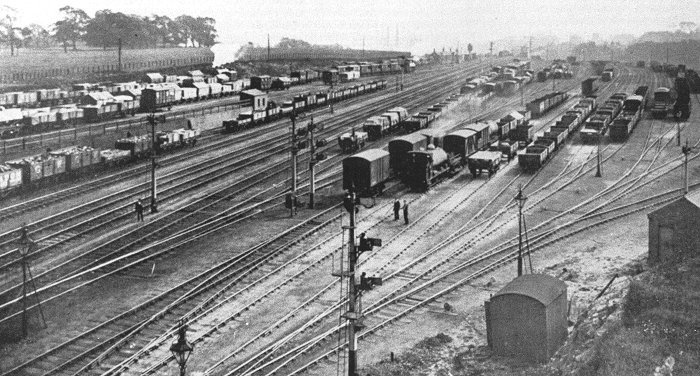
An undated view of Oxley Sidings
(possibly circa 1930) looking south, with the yard
developed to its fullest extent. The three open-cab
0-6-0STs actively shunting are likely to be
Wolverhampton products built at the GWR's Stafford Road
Locomotive Works, across the other side of Oxley
viaduct.During the
course of World War 11, Oxley sidings became a prime
target for Luftwaffe air-raids being carried out across
the industrial Midlands. Already one of the most
dangerous jobs on the railway, blackout restrictions
made the tasks of the yard shunting staff even more
hazardous. To enable sorting and shunting operations to
continue, all fixed lighting in the yard was provided by
way of 'fully restricted' lighting that remained on,
even during air-raid alerts. The term 'restricted'
either applied to the use of special-issue low-wattage
light bulbs (nicknamed 'gloomy glims'), or otherwise
simply by coating two or three of the glass panels on
the yard's gas lamps with matt black paint - the job of
marshalling a wartime goods train with such minimal
illumination was not an easy proposition. In addition,
locomotives at work in the yard were provided with
canvas anti-glare sheets in an attempt to block out any
glow from the firebox. Amazingly, Oxley sidings survived
the war unscathed, its ultimate demise coming from
within as a consequence of the British Railways
modernisation plans of the 1960s, and the
ever-increasing competition from road haulage. Author's
Collection. |
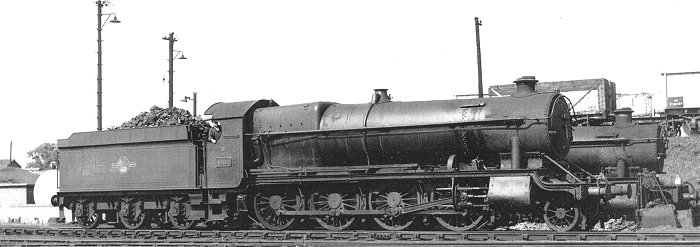
Evening freight workings from
Oxley sidings were often taken out by one of the
Churchward '4700' class 2-8-0s - No 4700 of that class
is seen coaled up and waiting leave Oxley shed. Once out
on the main-line near Oxley South box, this engine will
reverse into the Up sidings to collect a southbound
fitted-freight working. During their first years of use,
several of the '4700' class engines were allocated to
Oxley shed for use on night-time express freights
between Wolverhampton and London, and they continued to
be put to use from Oxley on a general freight basis over
the years; the class of nine engines would all be
withdrawn from service between June 1962 and May 1964.
J. B. Bucknall. |
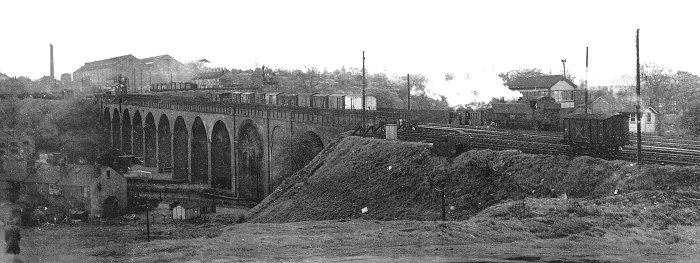
A view of Oxley viaduct, looking
south from the Up side of the main line on 2 May 1963,
with a Hawksworth 0-6-0PT positioned in front of Oxley
South signal box. The rear of the ex-GWR Stafford Road
Locomotive Works can clearly be seen on the skyline,
with less than a year to go before its closure. A short
goods train is being held in place by its brake van on
the viaduct, its locomotive having already been detached
and taken forward on to the shed. The houses glimpsed in
the lower left-hand side of this scene are at the start
of South Street and Jones Road which had provided homes
for generations of local railwaymen since the turn of
the century. Author's Collection. |
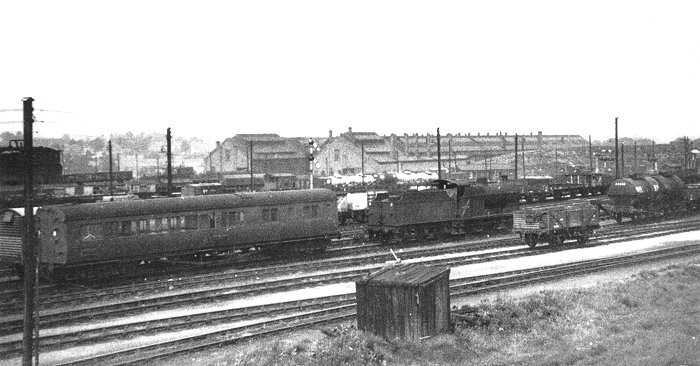
The view as seen in the opposite
direction from a similar vantage point, circa 1966, with
the sidings area in the foreground, and Oxley shed in
the distance. A Fowler '4F' 0-6-0 locomotive is seen
temporarily stored in the sidings whilst in transit for
scrapping. Note the high ground rising beyond the
smokebox of the Midland-designed engine, between the
north end of the sidings and the locomotive shed.
Author. |
|
The track layout of the modem maintenance facility
nonetheless still uses quite a large number of newly
laid roads, which are spread across the entire
complex. However, most of these are very much
shorter in length than those of the original Oxley
sidings. Inclusive of a Down goods loop, there are
some seventeen service roads off to the left-hand
side of the Down main line, the penultimate of which
is a single-track route that leads into the
maintenance building, which now occupies the entire
site of the old Oxley steam shed. Again, including
the Up goods loop, there are eight roads set down
off to the right-hand side of the Up main line, thus
in this way the present-day version of the sidings
continues to provide a very useful and major
centrally-located railway facility at Wolverhampton. |
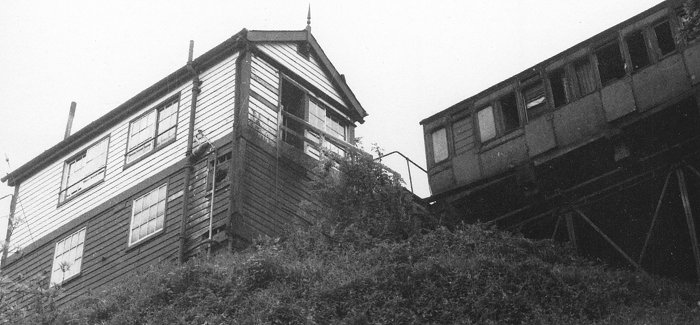
This 1966 view, looking up
from the Birmingham Canal, shows that Oxley South
signal box had seen few alterations to the original
structure, despite the passage of some seventy
years. The closure of the engine shed in 1967 would
precede the remodelling of Oxley yard, which would
see South box close on 30 March 1969 and
subsequently be demolished, a fate also suffered by
the six-wheeled 'droppers-in' coach seen on the
right of this view. A new modern-style signal box
came into operation on the same day the old box
closed, the replacement being situated on the
opposite side of the tracks leading to the viaduct.
Author. |
|
Oxley
Locomotive Sheds July 1907 to March 1967
During the Victorian period
the running sheds which were situated over at
Stafford Road, Wolverhampton had long served for
the maintenance of all of the
Wolverhampton-based Great Western Railway
locomotives. However, in 1905 the Directors of
the GWR authorised the building of a separate
shed for goods engines, which was to be located
over on the northern side of Oxley viaduct,
adjacent to the existing Oxley sidings. The
detailed building contract for the shed was
eventually approved in March 1906 and the
building operations were then put in the charge
of the company's newly appointed Works Engineer,
Walter Armstrong, the resident engineer being W.
E. Hart. The building contractors employed for
the task were the local Wolverhampton firm of H.
Lovatt & Co Ltd. In remarkably short time the
construction of Oxley shed was completed, and it
was opened for use from 1 July 1907.
The distinctive red
brick-built shed was situated on the Down side
of the main line. The design of the building
itself followed the standard Swindon 'Old Oak'
pattern, except that the narrowness of the site
dictated that the two interior turntables had to
be placed one behind the other. The design also
allowed for an extension of the shed and the
separate standard GWR double-ramp coaling bay,
and for the installation of at least a further
turntable at a future date. In the event, such
an enlargement was never required. The
turntables themselves were each 65ft in diameter
with under-support girders. The turntables were
each encircled by 28 inspection pits, these
varying from 41ft to 100ft in length. The
original shed code was OXY, which became 84B on
Nationalisation, and eventually the shed was
re-coded as 2B in 1963.
Other principal dimensions
at the shed were as follows:
Lifting Shop: 84ft x
58ft 6in
Stores (including Office): 72ft x 56ft
6in Mess Rooms: 176ft 6in x 15ft 6in
Lavatories: 30ft x 15ft 6in
Sand Furnace: 59ft x 25ft
Coal Stage: 52ft x 59ft 6in
The total area of the buildings amounted to some
98,960sq ft.
On the left of the main
shed building was the engine lifting shop, which
was provided with a 39-ton capacity overhead
hoist. The foreman's and administration clerk's
offices were situated over on the right. At the
northern side of the shed buildings were the
enginemens', mechanics' and cleaners' rooms
(with kitchen), and the lavatories; a standard
sand furnace was also provided. The gloom within
the shed was partly dispelled by large
nine-burner gas lamps suspended from the roof,
these being operated by chain pulls, whilst a
number of tall gas-lamp standards provided for
the shed yard were converted to electricity in
the 1950s, and a powerful overhead electric lamp
was also provided for night use at the coaling
bay.
Although additional
pressure was put on both shed work and goods
sorting during World War I, it was during the
course of World War II that Oxley sidings were
really put to task, dealing with ever increasing
amounts of crucial freight traffic, which in
turn created a constant upping of the general
locomotive maintenance over at the shed. It was
often said that Britain's railway system during
the war years was the lifeline of the nation,
and the contribution to the war effort made by
the staff of Oxley sidings and shed cannot be
underestimated. It was expected that the GWR's
Wolverhampton Locomotive Works, sheds, and the
sidings at Oxley would no doubt sooner or later
receive a visit from Luftwaffe bombers. As a
consequence, during the blackout hours the
official Oxley shed fire guards and Air Raid
Precautions look-outs would set themselves up on
the roofs and other elevated locations to keep
watch for any approaching aircraft, or indeed
for fires caused as a result of bombs or
incendiary damage. |
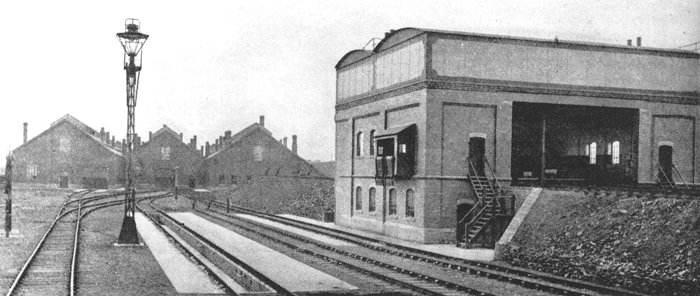
An official GWR
photograph from 1907 shows the south end of
the newly-completed Oxley engine shed, the
general layout of the shed yard and its
standard double-ramp coaling bay, complete
with its overhead water tank. The left-hand
(west) side of the coal stage was for use by
goods locomotives, whereby the other side
would be much lesser used, it being for
passenger locomotives. The door at the
bottom left-hand side of the structure was
the entrance to the coalman's cabin, and a
similar door, out of view, led to the tool
house. Author's Collection. |
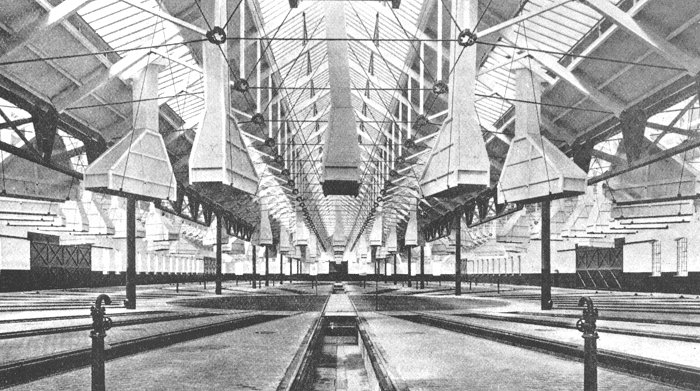
Another scene
taken by the GWR photographer
(presumably on the same day) captures
the interior of Oxley locomotive shed
after completion of the building work,
but just prior to its opening on 1 July
1907. The moment in time finds the
massive building without locomotives to
obscure the view, so the arrangement of
lines radiating from both turntables is
clearly apparent. Author's Collection. |
|
A substantial purpose-built
structure with a sloping roof was also erected over
the ash disposal pits in the shed yard, so as to
prevent any illumination being given out by the hot
coals and ash from the locomotives. Photographs
showing the ash pit screening in place appear to be
somewhat scarce, but one such photograph, taken from
some distance away (possibly in the late 1940s) does
show the remains of the camouflage painting, which
would have been applied to break up the outline of
the buildings, making it less conspicuous from the
air. Incredibly, such a visit from the Luftwaffe
never took place, and therefore Wolverhampton's
railway centres all survived the war intact.
Some Italian prisoners of war were also employed at
Oxley shed, mainly on coaling duties and other
labour-intensive jobs, and some of these Italians
decided to settle in Wolverhampton after the
cessation of hostilities in 1945. The only incursive
aircraft that might have posed any threat to Oxley
was hit by a 'secret weapon' located on the Dunstall
racecourse, sited below the sheds. The ash pit
screening was soon removed following the end of the
war, and some concrete panels, which can be seen in
many photographs of the shed yard, may be the
remains of the larger screening structure, but this
is debatable. |
| At the south-west comer of
Oxley shed was the lifting shop.
The 84ft x 56ft 6in building's
lifting bay hoist is seen in its manual days, rather
than when later electrified. It had a 39-ton
capacity, with a clear lift of 19ft; to this was
fitted a six-ton swinging jib crane for lighter
loads.
The service tools were also
kept here, the place being kept spotlessly clean in
GWR days.
Author's Collection. |
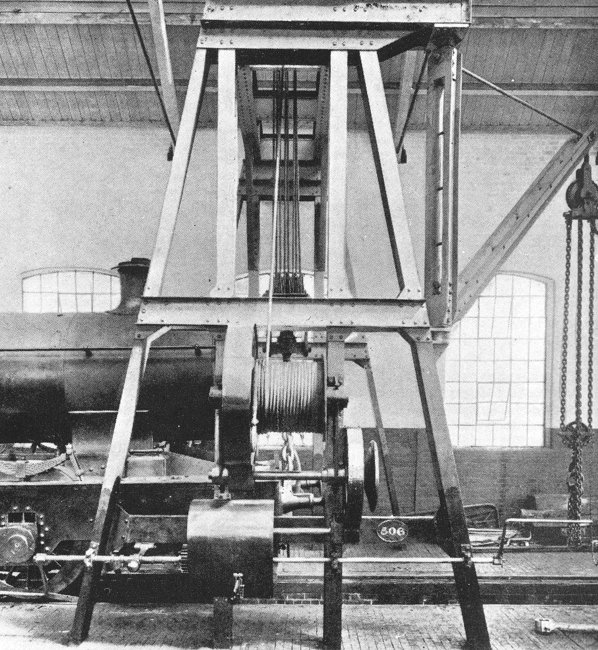 |
|
The post-war years and into the 1950s saw little
alteration in the normal operating routine at the
shed. However, as a result of the modernisation
scheme that was now being implemented by British
Railways, significant changes were on the horizon.
January 1963 saw both Stafford Road and Oxley depots
come under the control of British Railways (London
Midland Region).
In the September of that year the now rundown former
GWR shed at Stafford Road was closed and its stud of
engines and all its locomotive servicing (together
with most of the shed staff) were transferred to
Oxley. Additionally, on the closure of the old LMS
(ex-London & North Western Railway) shed at Bushbury
on Monday, 12 April 1965, that shed's remaining
allocation of engines was also sent across to Oxley,
and these locomotives were at first lined up in two
adjacent rows at the rear of the shed during the
summer months of that year. Some of the staff from
Bushbury also transferred over to Oxley, or in some
cases they took the option to retire or go and work
elsewhere. For a short while Oxley became three
sheds in one, providing something of a swansong of
steam at Wolverhampton. |
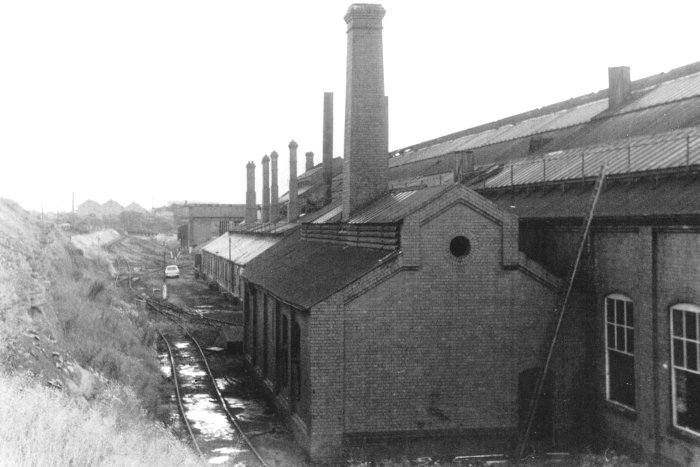
A view along the eastern side
of the main shed building, looking south after its
closure in 1968, shows the rear of the sand hearth
and boiler-house building, with the mess rooms
beyond that. Hard though it may be to believe, soon
the latter's 176ft 6in long lean-to structure along
the south end of the shed's eastern wall would be
the only part of the building that would survive.
Beyond the shed is the eastern side of coaling
stage, and Stafford Road Locomotive Works is just
visible in the distance. The main line and Oxley
sidings are on the other side of the bank to the
photographer's left, while close inspection of the
sand hearth roofline shows the extended chimneys of
two south-facing stationary boilers, as well as the
larger chimney of the sand hearth itself. Simon
Dewey. |
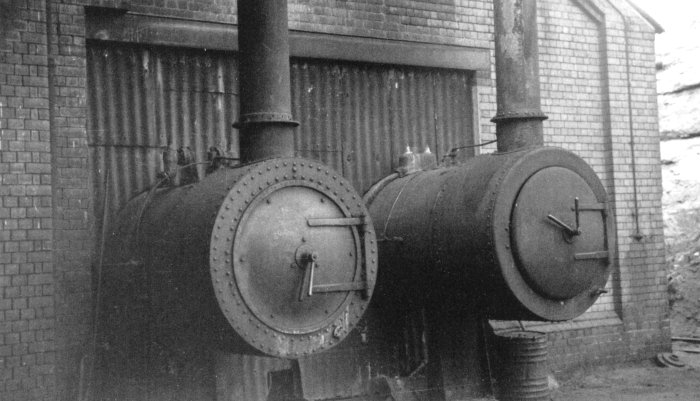
A view of the opposite wall of
the same building shows the smokeboxes of two
stationary boilers used at Oxley shed to provide hot
water and steam for washing out the shed. Of
differing vintage, they were previously on GWR
locomotives. The building where they were housed was
known to Oxley staff as the 'sand hearth', taking
its name from an adjoining riveted bunker where sand
was dried out for use in locomotive sanding
apparatus. These boilers were installed about 1962,
and they were last washed out on 17 July 1967.
Although the shed had in fact been formally closed
down in March of that year, a number of steam
locomotives still received light running repairs
until the late summer, and clearly the boilers were
maintained until at least the last wash-out date.
Simon Dewey. |
 |
|
 |
|
 |
Return to the exhibition
transport services hall |
|
Return to the museum
transport hall |
|
Proceed to
part 2 |
|